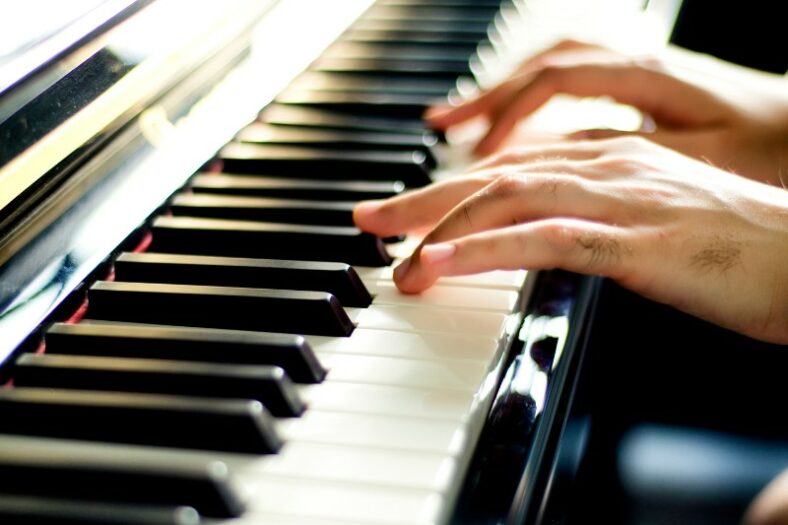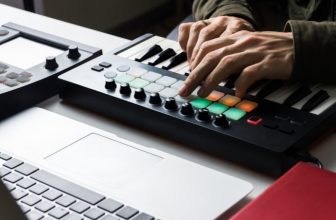Playing With Both Hands (Piano Learning Exercises)

Many beginner pianists struggle to play with both hands, even though they can play the left and right-hand parts separately. Playing two different parts with different hands is one of the trickiest parts of playing piano. Fortunately, there are fantastic exercises to work on your coordination.
Even experienced pianists sometimes struggle with hand coordination when playing technically challenging or rhythmically complex partitions. Hand coordination when playing piano is a great brain exercise for developing new neural pathways.
The key is to break the sequence down into smaller parts and master the parts slowly and individually, creating muscle memory and the necessary connections in your brain to play the part properly with good technique.
These seven exercises will help you significantly on the way.
Contents
1. Two-Handed Scales
The first exercise you can add to your playing routine is the two-handed scale practice. You can choose a scale and start playing it with both hands. While the left hand starts to play from the lower root note, the right hand will play the same scale starting from the octave.
To play a two-handed scale, you should already be able to play the chosen scale individually, both with the left and right hand. When you are comfortable with that, you can start playing both simultaneously.
Start with pentatonic scales, which feature only 5 notes. For example, put your left pinky finger on the low C note and your right thumb on the middle C note. Now, play the whole scale slowly in ascending order. You will play C, D, E, F, and G notes. When you get that, try to come back down to the C again. If you struggle with playing 5 notes, you can start with the first 3 notes of the scale and move on to 5-note scales later. When you manage that, it is time to practice the whole scale.
Two-handed scale exercises are great for building coordination while learning the scales and finger positions. Always be aware of using the recommended fingers for the notes, and practice one scale at a time to build muscle memory. Try to practice this daily for a good 10 to 15 minutes at least. If you struggle with hand coordination as a beginner, you are not alone. It’s just a matter of taking it slow and practicing every day to get the hang of it.
2. Mirror Scales
When you are comfortable with playing a scale-up and down together, you can add a new challenge to create right and left-hand independence. So, this time you will play the scale in the opposite directions. You will start with thumbs playing outwards and come back inwards later.
So, imagine a mirror between your right and left hand on the piano. Basically, your hand will play the reflection of your other hand. This movement is called contrary motion.
For example, if you practice the C pentatonic major scale, your left thumb will start from the low G note, while the right thumb will start from the middle C note. The left hand will go into descending order until it reaches the root note C and start ascending from there. And the right hand will go up to the G note before descending back to the C note.
This exercise can be tricky at first attempts, as it requires a bit of right and left-hand independence. Your fingers will want to get back into the same movement your other hand does. You will have to keep them in control. So, start slowly and gradually build up the speed as your fingers find the right locations without you thinking about them.
Another important trick is keeping your fingers grounded on the keys instead of making them fly off the piano. You can start practicing the mirror scales with C major pentatonic scale and later move to other scales.
3. Combo Rhythms
Playing combo rhythms is a great way to practice hand coordination on the piano. For this exercise, both hands will play notes with different time values. For example, while the left hand plays a single note, the right hand plays two notes.
There are various combinations of this exercise. First, you can start with the 1 for 2 pattern, where the left hand plays one note while the right-hand plays 2. And, then you can change the pattern to 2 for 1, which means the left-hand plays 2 notes and the right hand 1.
The next challenge is adding triplets instead of two notes. One hand will play 3 notes while the other plays a single one. Later comes the 4-for-1 pattern. Try the pattern with both hands, and as always, start slowly and be aware of your technique. Never rush the exercises.
The combo rhythms are great for building hand coordination and rhythmic consistency, which can help you a lot when playing songs.
4. Polyrhythms
Polyrhythm is an advanced technique where two different rhythmic patterns that are not derived from each other are played simultaneously. For example, to create a polyrhythm, you can play 3 notes with your right hand while playing 2 notes with your left hand in the same period.
You can first try tapping exercises with the 3 to 2 polyrhythm to get the feeling right. So, try to tap on a table or your legs or anywhere with your left hand playing duplets and your right-hand triplets. When you can manage that, change your hands.
If you get confused, you can use the “Hot Cup Of Tea” technique to help. So, say “Hot Cup Of Tea” while tapping with the polyrhythm. When you say “Hot,” both hands will be tapping, “Cup” is the second beat of the triplet, “Of” is the second beat of the duplet, and “Tea” is the last beat of the triplet.
Afterward, you can start applying this technique to the piano. So, in the case of this exercise, your right hand will play E and B notes while the left hand plays the C-G-C progression. Later, you can change hands by playing different notes in the C major scale. You can add more notes when you feel comfortable and try the exercise in the video reference.
Polyrhythms force the brain to separate both hands and build strong independence. Playing different polyrhythms is a great way to create strong hand coordination. There are many different polyrhythms, but it is better to stick with the most basic one for beginners. You can use the other polyrhythm patterns when you become a more experienced player.
5. Two-Handed Chords
A very common technique used in many piano songs is the two-handed chords. Some chords include many notes, so you need both hands’ engagement. Or you can play the same chord in different octaves to create a richer sound. You can arpeggiate the chords or play the notes at the same time.
For example, you can play a C major chord with the left hand playing C-G and the right-hand playing E-G-C- notes on the next octave. While playing these chords can be easy, the exercise creates sequences with two-handed chords. As shown in the reference video, you can play arpeggios or different rhythmic patterns with chords to build hand coordination.
6. Alternating Rhythms/Notes
Playing chords and-or notes in an alternating order is another great exercise for developing two-hand coordination. Alternating notes is basically playing a note or a chord with one hand followed by a note or a chord with the other hand.
Alternating rhythm is quite simple as you play one note, followed by the other, steadily and straightforwardly. But, moving both hands to different notes requires quite an independence in both hands, which is the challenging part that will help you build two-hand coordination.
You can find many exercises or songs to develop the alternating hand technique. You can also create your own exercises. Just create a chord progression like C (CEG), G (GBD), Am (ACE), and F (FAC), and try to play the chords with both hands one at a time.
So, each chord will be played two times, first with one hand and then the other. You can also play chords with one hand and a single note of the same chord with the other in an alternating fashion. The same goes for single notes, too.
7. Bonus Tip: Don’t Rush
The most important tip for all the exercises is to avoid rushing the exercise, starting slowly and gradually building up the speed. With hand coordination, it is not about speed but technique and quality. Start slowly to prevent bad habits and techniques; the speed will naturally come.
As with most instruments, playing piano is about creating the necessary muscle memory to play comfortably. Always use a metronome with every exercise, and put the BPM to lower grades, like 40 BPM. When you can complete the exercise properly for a few back-to-back rounds, try to increase the speed by 10 BPM each time.
Is hand independence hard on the piano?
Hand independence is one of the hardest techniques for beginner pianists as our brains are not usually used to moving our hands independently, at different speeds, and with different levels of strength. It requires good hand coordination, developed with many hours of practice.
You can prove this with a basic exercise. Try tapping your head with one hand while rubbing your belly in a circular motion with the other hand. Then change the motions tapping your belly and rubbing your head. And, later, change hands and repeat the process. Even with this basic exercise, your brain gets confused if you do not have the training.
How to master hand independence?
To master hand independence, you must put time and effort into exercises. Start slowly, practice daily, watch many videos, and gradually progress with speed and complexity. Never rush and put quality before speed. You must give your brain time to process and your muscles to have the memory.
Conclusion
So, hand independence is a crucial skill that even experienced players struggle with sometimes. It is the foundation for playing complex musical pieces and building advanced techniques and skills. With the right practice routine as well as putting time and effort into the exercises, anyone can progress with two-hand coordination and hand independence on the road to becoming a successful pianist.





